VOICE OF FLAME
“Ahilyabai Ki Kahani, Maheshwar Ki Zubani”: A Reflection on the Discover India Program Experience
26 Jul 2024 | Author: Kriti Bhargava |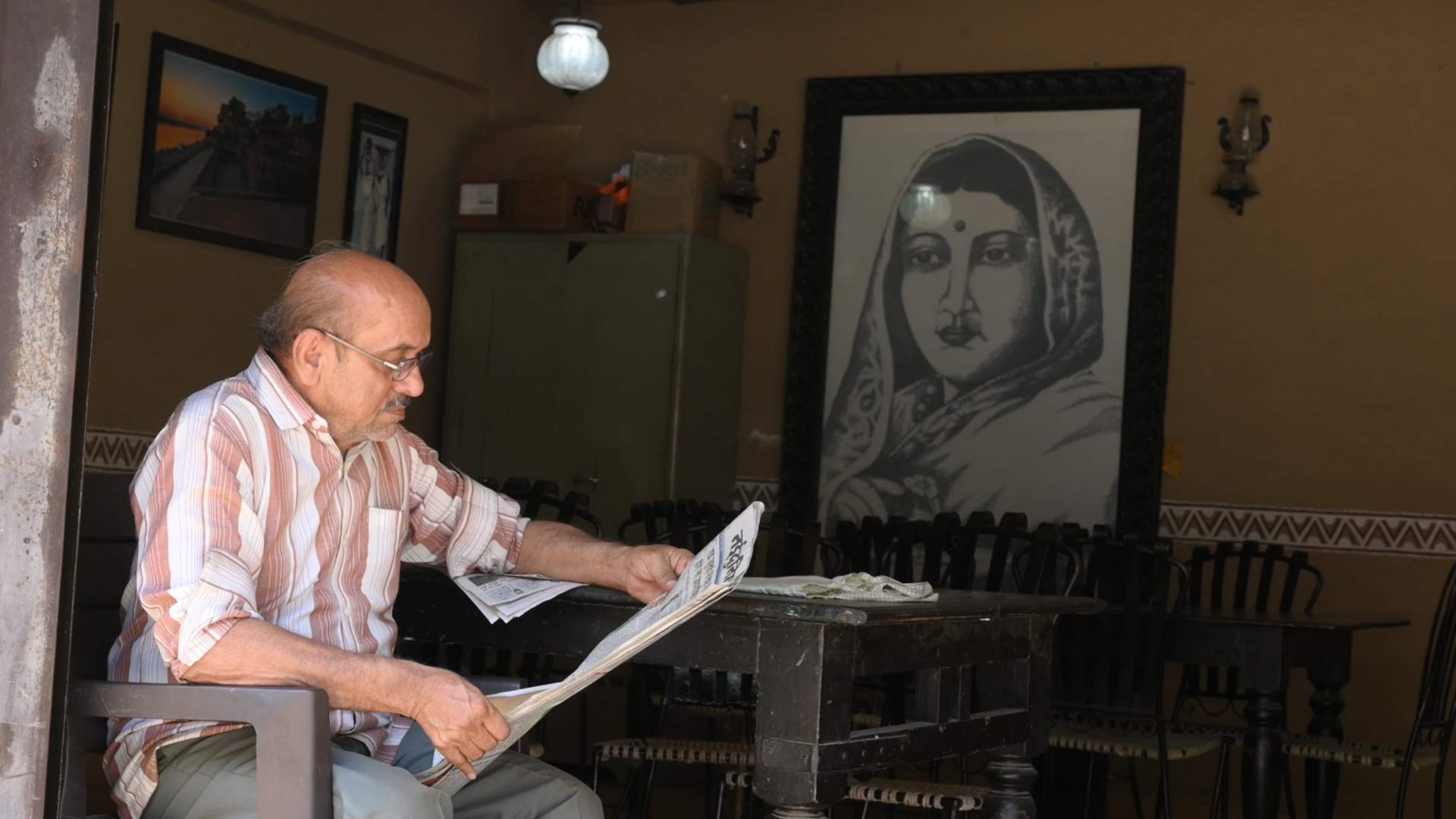

“Ahilyabai Ki Kahani, Maheshwar Ki Zubani”: A Reflection on the Discover India Program Experience
The Discover India Program (DIP) at FLAME University stands as a flagship initiative aimed at immersing students in India's cultural, historical, and social landscapes. This program mandates that students form groups and work together for seven to eight months, conducting research, pre-field and post-field presentations, and culminating in a final documentary. Our team of 13 students embarked on a journey to Maheshwar, Madhya Pradesh, to explore the profound impact of Queen Ahilyabai Holkar under the name “Ahilyabai Ki कहानी, Maheshwar Ki ज़ुबानी”. This blog chronicles our project, research findings, and our unforgettable journey as a team.
Exploring the Rich Cultural and Historical Heritage of Maheshwar
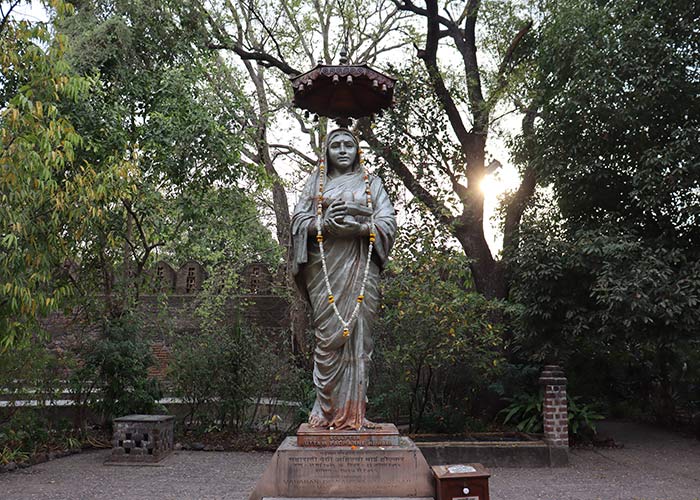 Maheshwar, once known as Mahishmati, is rich in cultural and historical heritage. The serene Narmada River flowing through it adds to its charm, attracting visitors and pilgrims worldwide. Queen Ahilyabai Holkar, a remarkable female ruler in a predominantly patriarchal era, played a pivotal role in preserving and promoting the town’s culture and heritage. Known for her contributions to building and preserving significant religious temples across India, her political and administrative prowess is often overshadowed. Our research explored how her defining characteristics contribute to people’s perception of her today. We delved into how her architectural projects in Maheshwar influenced the contemporary cultural landscape and examined her role in establishing the handloom industry. Additionally, we aimed to understand how her rule and endeavors have impacted Maheshwar’s society today.
Maheshwar, once known as Mahishmati, is rich in cultural and historical heritage. The serene Narmada River flowing through it adds to its charm, attracting visitors and pilgrims worldwide. Queen Ahilyabai Holkar, a remarkable female ruler in a predominantly patriarchal era, played a pivotal role in preserving and promoting the town’s culture and heritage. Known for her contributions to building and preserving significant religious temples across India, her political and administrative prowess is often overshadowed. Our research explored how her defining characteristics contribute to people’s perception of her today. We delved into how her architectural projects in Maheshwar influenced the contemporary cultural landscape and examined her role in establishing the handloom industry. Additionally, we aimed to understand how her rule and endeavors have impacted Maheshwar’s society today.
Field Visits, Archival Research, and Interviews in Maheshwar
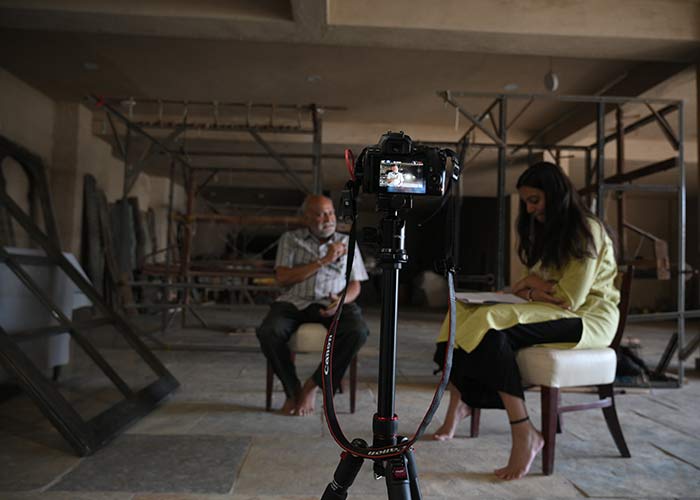 Our methodology comprised field visits, archival research, documentation, and interviews. We conducted field visits to places like Ahilya Fort & Rajwada, Narmada Ghat, temples, chhatris, and other historical landmarks. These provided invaluable context and deepened our understanding of Ahilyabai's impact on the region. Interacting with residents, artisans, temple priests, and tourists during these visits enriched our research by capturing diverse perspectives and narratives.
Our methodology comprised field visits, archival research, documentation, and interviews. We conducted field visits to places like Ahilya Fort & Rajwada, Narmada Ghat, temples, chhatris, and other historical landmarks. These provided invaluable context and deepened our understanding of Ahilyabai's impact on the region. Interacting with residents, artisans, temple priests, and tourists during these visits enriched our research by capturing diverse perspectives and narratives.
 We conducted 55 interviews, covering a wide range of categories and occupations, including Indian and foreign tourists, locals, shopkeepers, priests, weavers, businessmen and women, members of the royal family, professors, museum authorities, and common people. Notable interviews included those with Mr. Richard Holkar and Mr. Yeshwant Rao Holkar, descendants of Queen Ahilyabai Holkar, and various scholars who had extensively researched the Queen.
We conducted 55 interviews, covering a wide range of categories and occupations, including Indian and foreign tourists, locals, shopkeepers, priests, weavers, businessmen and women, members of the royal family, professors, museum authorities, and common people. Notable interviews included those with Mr. Richard Holkar and Mr. Yeshwant Rao Holkar, descendants of Queen Ahilyabai Holkar, and various scholars who had extensively researched the Queen.
Exploring Ahilya Fort, Narmada Ghat, and Other Historical Landmarks
 During our research, we meticulously documented various significant sites in Maheshwar. Ahilya Fort & Rajwada, where the walls echoed key moments of Queen Ahilyabai's life, provided us with a profound understanding of her legacy.
During our research, we meticulously documented various significant sites in Maheshwar. Ahilya Fort & Rajwada, where the walls echoed key moments of Queen Ahilyabai's life, provided us with a profound understanding of her legacy.
 At Narmada Ghat, we captured the vibrant processions of the Narmada River Festival and conducted interviews to gather diverse perspectives. Our visits to Raj Rajeshwar Temple, Baneshwar Temple, Kashi Vishwanath Temple, and Ahilyeshwar Temple allowed us to participate in pujas and witness processions, offering us firsthand experiences of the pilgrim's journey.
At Narmada Ghat, we captured the vibrant processions of the Narmada River Festival and conducted interviews to gather diverse perspectives. Our visits to Raj Rajeshwar Temple, Baneshwar Temple, Kashi Vishwanath Temple, and Ahilyeshwar Temple allowed us to participate in pujas and witness processions, offering us firsthand experiences of the pilgrim's journey.
The Impact of Ahilyabai on Maheshwar’s Handloom Industry
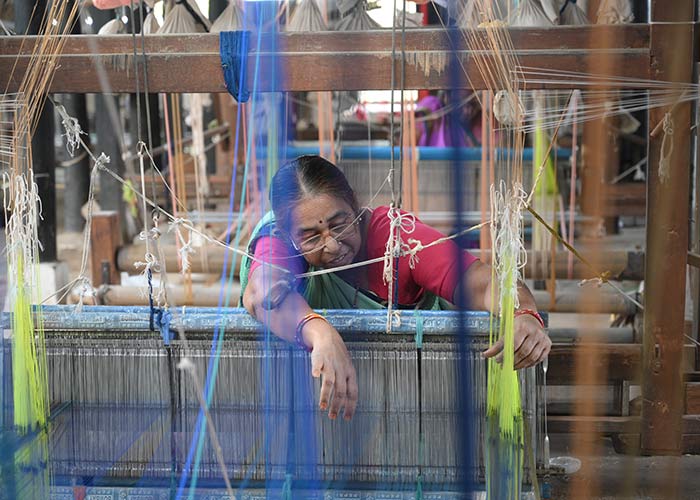 Exploring the REHWA Society, Women Weave, and other handlooms, we delved into the intersection of history, culture, and craftsmanship, highlighting Ahilyabai's emphasis on empowering women weavers. Additionally, we visited the homes of various weavers and strolled through the streets of Maheshwar, where the sound of looms ringing in each house lingered in our minds, fueling our productivity. Our journey also took us to Omkareshwar, where we sought to understand Ahilyabai’s contributions and the public perception of her impact on this town of great religious significance, lined with temples and housing one of the twelve Jyotirlingas (a special shrine where Lord Shiva is worshipped in the form of a fiery column of light).
Exploring the REHWA Society, Women Weave, and other handlooms, we delved into the intersection of history, culture, and craftsmanship, highlighting Ahilyabai's emphasis on empowering women weavers. Additionally, we visited the homes of various weavers and strolled through the streets of Maheshwar, where the sound of looms ringing in each house lingered in our minds, fueling our productivity. Our journey also took us to Omkareshwar, where we sought to understand Ahilyabai’s contributions and the public perception of her impact on this town of great religious significance, lined with temples and housing one of the twelve Jyotirlingas (a special shrine where Lord Shiva is worshipped in the form of a fiery column of light).
Tourism, Handlooms, and the Cultural Impact of a Remarkable Ruler
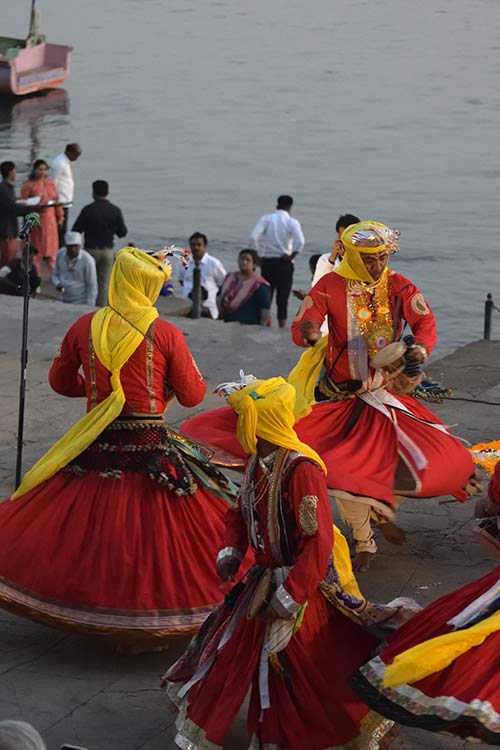 We observed that Queen Ahilyabai continues to live on in the hearts of the people of Maheshwar. Her impact is felt not only through fond memories and admiration but also through her significant contributions to the economic growth of the tourism and handloom industries. Queen Ahilyabai’s legacy in tourism is evident in her architectural contributions that draw visitors from near and far.
We observed that Queen Ahilyabai continues to live on in the hearts of the people of Maheshwar. Her impact is felt not only through fond memories and admiration but also through her significant contributions to the economic growth of the tourism and handloom industries. Queen Ahilyabai’s legacy in tourism is evident in her architectural contributions that draw visitors from near and far.
In the handloom industry, her influence goes beyond inspiring the unique designs of the sarees. It is embedded in the very ideology of the industry: adapting to the times and progressing alongside society for the greater good. Her efforts in providing employment to the people of Maheshwar and empowering women to stand on their own feet make the handloom industry a crowning achievement for both the Queen and the town.
 From old tales in storybooks to her striking pictures adorning shops, restaurants, schools, and homes, Queen Ahilyabai is revered and acknowledged as the foundation of Maheshwar's prosperity. Among weavers and locals, her reign is particularly remembered for its emphasis on women's empowerment, as evidenced by her support for female artisans and initiatives promoting their economic independence. Her abilities as a just and intelligent administrator are truly inspirational and should be shared with more and more people across the globe.
From old tales in storybooks to her striking pictures adorning shops, restaurants, schools, and homes, Queen Ahilyabai is revered and acknowledged as the foundation of Maheshwar's prosperity. Among weavers and locals, her reign is particularly remembered for its emphasis on women's empowerment, as evidenced by her support for female artisans and initiatives promoting their economic independence. Her abilities as a just and intelligent administrator are truly inspirational and should be shared with more and more people across the globe.
The Start of an Incredible Journey: Preparing for the Discover India Program
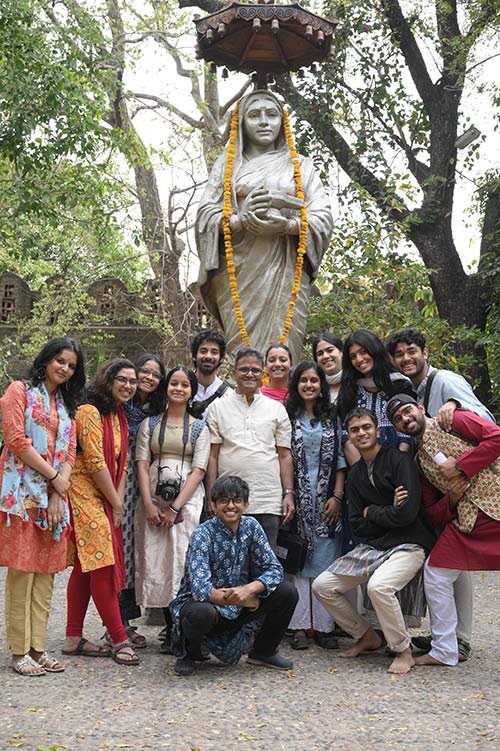 “We never knew we were DIPing ourselves in a pool of memories, all we knew was we were learning something and having fun.”
“We never knew we were DIPing ourselves in a pool of memories, all we knew was we were learning something and having fun.”
It all started with a single email from the Discover India Program (DIP) committee-a simple notification that would lead to one of the most memorable experiences of our lives. As we read the email, excitement mingled with anxiety.
After carefully deciding on our team members and faculty mentors, we were divided into four groups, each with its distinct responsibilities:
- Content Team: This team was responsible for the research aspect of our project. They dived deep into the history and impact of Queen Ahilyabai Holkar.
- Logistics Team: This team planned our field trip. They ensured that everything from travel arrangements to accommodations was in place and within budget.
- Finance Team: Responsible for managing our budgets and expenditures, the team ensured that we stayed within the financial constraints of the project.
- Documentation Team: Responsible for documenting interviews, and events, and creating a compelling narrative for our research project.
Pre-Field Presentation and Planning for the Journey
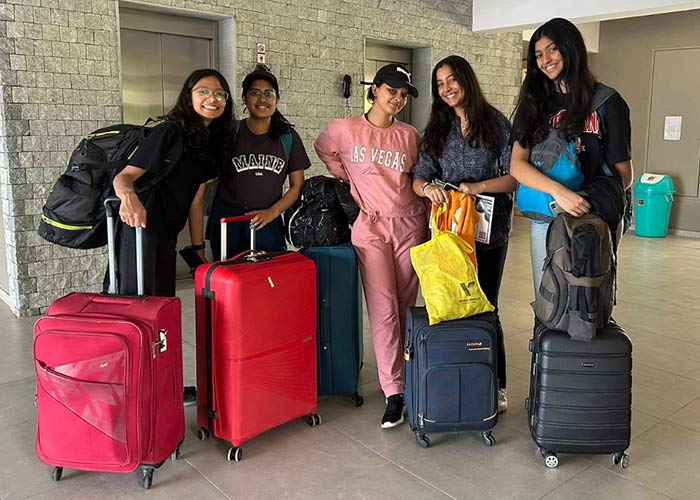 The Pre-Field Presentation was a significant milestone for the project and the committee’s praise boosted our morale. The content team spent hours on rigorous research, countless hours reading papers, and kept constant vigilance against plagiarism. The logistics team worked tirelessly to establish contacts and plan the details of our trip, navigating numerous rejections but persisting with unwavering determination. The documentation team practiced with cameras, tripods, and microphones, while the finance team kept a sharp eye on the budget, constantly reminding us to stay within limits.
The Pre-Field Presentation was a significant milestone for the project and the committee’s praise boosted our morale. The content team spent hours on rigorous research, countless hours reading papers, and kept constant vigilance against plagiarism. The logistics team worked tirelessly to establish contacts and plan the details of our trip, navigating numerous rejections but persisting with unwavering determination. The documentation team practiced with cameras, tripods, and microphones, while the finance team kept a sharp eye on the budget, constantly reminding us to stay within limits.
Adventures, Discoveries, and Team Bonding in Maheshwar
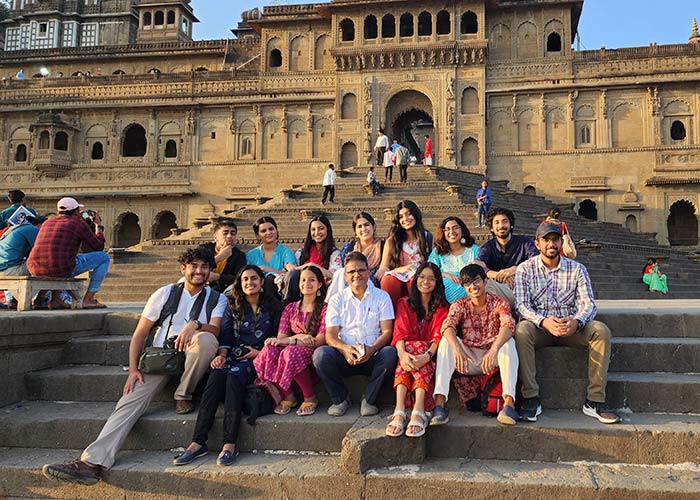 Finally, the day arrived. We packed our bags-overstuffed and heavy with hopes and aspirations-and set off for Maheshwar. The train ride was filled with excitement and camaraderie. We played card games, learned new ones, fought over Ludo games, and created makeshift movie nights using a bedsheet and a projector. These moments of joy and togetherness built our excitement for the experiences to come. In Maheshwar, we were immersed in the town’s rich history. We interviewed local weavers, struggling to communicate in our imperfect Hindi but finding joy in our efforts. We explored the ancient forts, the ghats of the Narmada River, and temples, learning about the revered Queen Ahilyabai Holkar and her remarkable legacy.
Finally, the day arrived. We packed our bags-overstuffed and heavy with hopes and aspirations-and set off for Maheshwar. The train ride was filled with excitement and camaraderie. We played card games, learned new ones, fought over Ludo games, and created makeshift movie nights using a bedsheet and a projector. These moments of joy and togetherness built our excitement for the experiences to come. In Maheshwar, we were immersed in the town’s rich history. We interviewed local weavers, struggling to communicate in our imperfect Hindi but finding joy in our efforts. We explored the ancient forts, the ghats of the Narmada River, and temples, learning about the revered Queen Ahilyabai Holkar and her remarkable legacy.
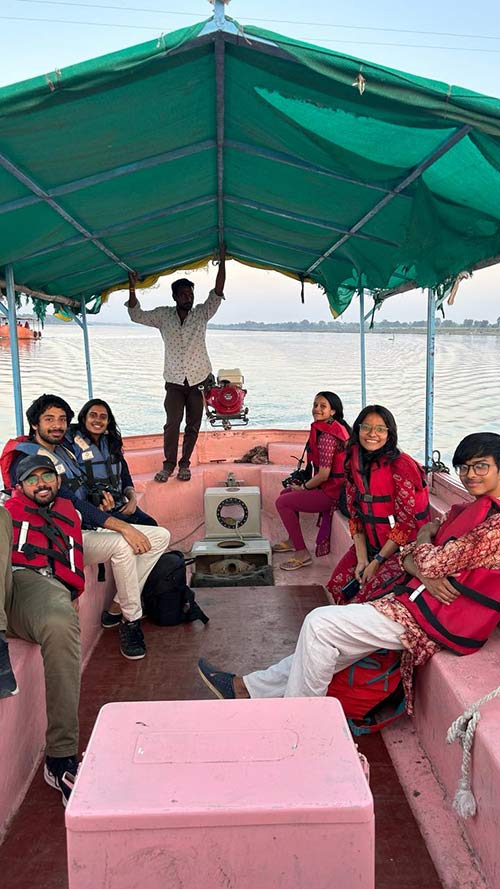 Boating on the Narmada, spending time at the ghat, and enjoying the meals together, were among the highlights. We also visited Indore, where we indulged in the famous snacks at 56 Dukaan, and Omkareshwar, where we braved the crowds to visit a revered temple and enjoyed another boating experience. Throughout the trip, we shared countless moments of joy and laughter. We played games, had impromptu jam sessions, made reels, and captured every little detail of our adventure.
Boating on the Narmada, spending time at the ghat, and enjoying the meals together, were among the highlights. We also visited Indore, where we indulged in the famous snacks at 56 Dukaan, and Omkareshwar, where we braved the crowds to visit a revered temple and enjoyed another boating experience. Throughout the trip, we shared countless moments of joy and laughter. We played games, had impromptu jam sessions, made reels, and captured every little detail of our adventure.
Showcasing Our Research Findings and Documentary
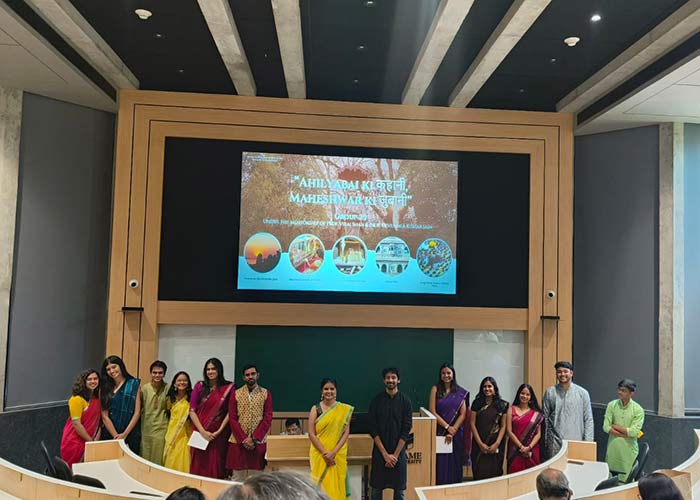 The final presentation was a culmination of our hard work. We dressed up in the Maheshwari sarees we had bought during the trip, and the boys sported kurtas for the occasion. We showcased our research findings and the documentary we had created with so much effort. In the grand tapestry of life, our DIP journey is a vivid thread-rich with color and emotion-that we will carry with us as we move forward. It reminds us that the most meaningful experiences are those where we push beyond our limits, embrace the unknown, and find beauty in both the struggle and the triumph. The Discover India Program was not just a chapter in our lives but a beautiful prelude to the endless possibilities that lie ahead.
The final presentation was a culmination of our hard work. We dressed up in the Maheshwari sarees we had bought during the trip, and the boys sported kurtas for the occasion. We showcased our research findings and the documentary we had created with so much effort. In the grand tapestry of life, our DIP journey is a vivid thread-rich with color and emotion-that we will carry with us as we move forward. It reminds us that the most meaningful experiences are those where we push beyond our limits, embrace the unknown, and find beauty in both the struggle and the triumph. The Discover India Program was not just a chapter in our lives but a beautiful prelude to the endless possibilities that lie ahead.
Team Members: Aarya Khemka, Akshat Sharma, Ananya Chenny, Ananya Sudarsanam, Dhruv Jetty, Kalash Shah, Kriti Bhargava, Manya Guglani, Mimansa Sharda, Mrinangshu Sengupta Das, Nishka Gandhi (Group Representative), Prajas Naik, Vineesha Vuppala
Mentors: Prof. Viraj Shah, Faculty of History, and Prof. Devendra Kumar Jain, Faculty of Finance
(Author: Kriti Bhargava, Undergraduate Student)






